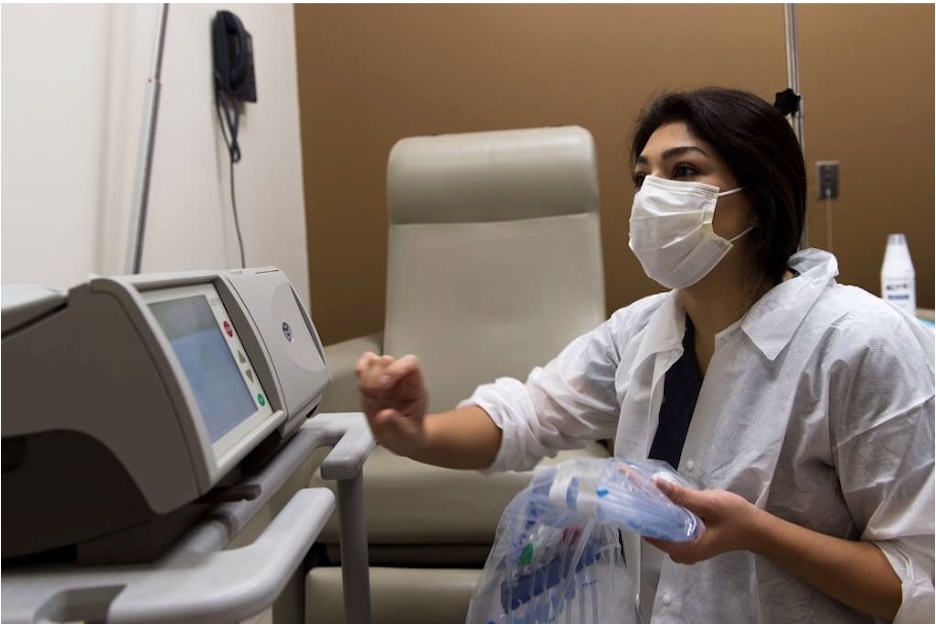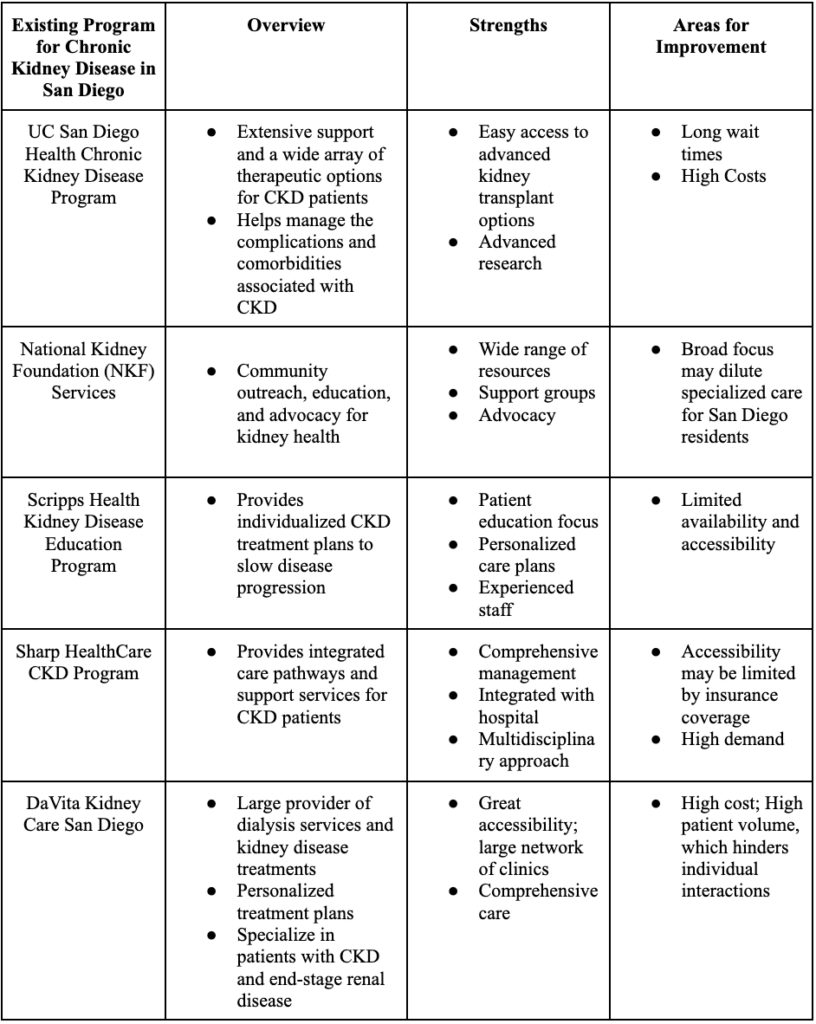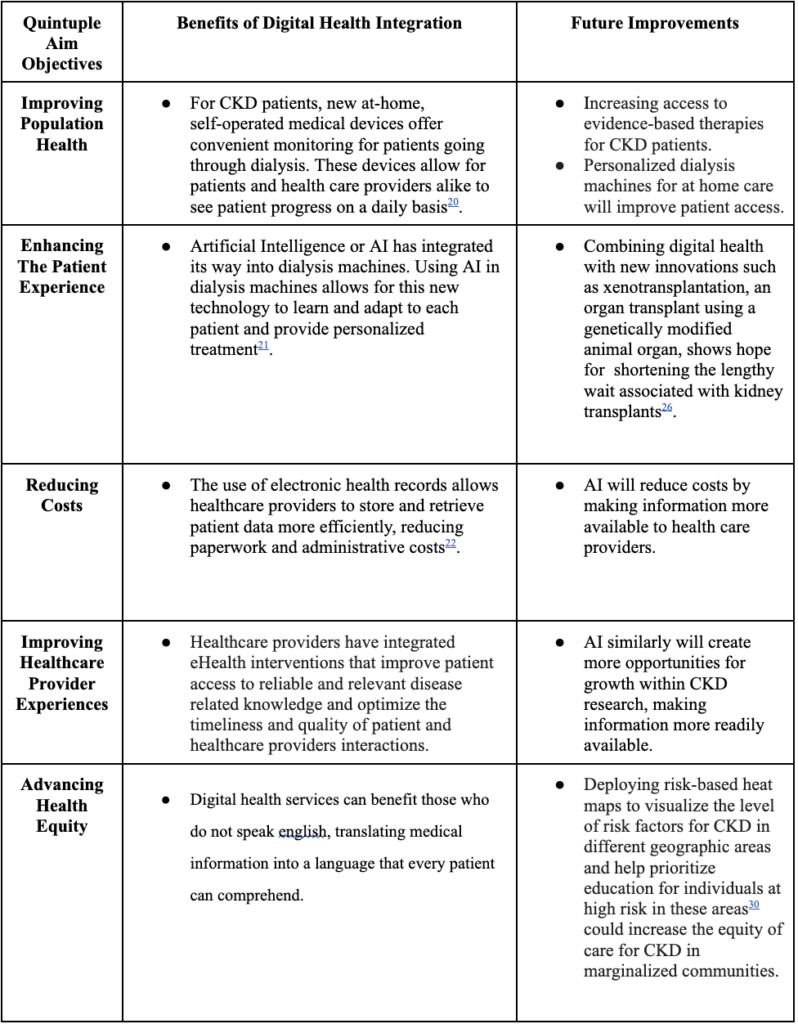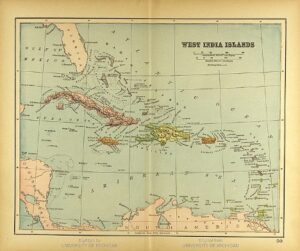This publication is in proud partnership with Project UNITY’s Catalyst Academy 2024 Summer Program.

Abstract
Background: Chronic Kidney Disease (CKD) is a condition in which an individual’s kidney slowly stops functioning and they become dependent on dialysis1. CKD affects about 1 in 7 US adults. Although this condition is well-managed within hospitals and dialysis clinics, it is not thoroughly discussed outside of the clinic. This lack of public emphasis on CKD causes an overall lack of awareness of its existence, and the disease often goes undetected within people who are in its earlier stages. Objective: To research and investigate the core factors that influence the health of individuals with CKD and design an evidence-based intervention to benefit adults age 40 and older in San Diego, California. Methodology: To complete this report we consulted 55 articles from Pubmed, the Centers for Disease Control (CDC), the National Kidney Foundation, and other sources that involve CKD on the national level and/or in San Diego. Additionally, a district health-pathway coordinator and a S-ICU nurse from San Diego were interviewed to gain further insight into the determinants of CKD and potential public health solutions. The findings from the literature review and stakeholder interviews were all synthesized in a plan of action. Results: The populations with the highest rate of CKD in San Diego are people aged 40 and above, who have a family history of kidney disease, or have pre-existing conditions such as hypertension or diabetes2. Conclusion: CKD is a prevalent issue within the San Diego community. This report puts forward a sustainable plan of action to benefit individuals 40 and above at risk of the disease. Considering its commonality, there should be an expanded focus on CKD education.
Keywords: Public Health Intervention, Chronic Kidney Disease, CKD, Kidney Disease, Dietary Restrictions, CKD education
Introduction
Chronic Kidney Disease (CKD) is a condition that affects ~850 million people yearly worldwide3. Each year, Medicare spending totals $130 million (more than 24% of total spending) for patients with CKD, but the disease is far less prevalent in public conversation than diseases like cancer or heart disease. CKD is known as a “silent killer” because it progresses fast without showing symptoms. Thus, ongoing research to uncover the risk factors and early symptoms of the disease are important for improving patient outcomes. It is also essential to better communicate the findings of these studies so that patients and their providers can act on them.
The dietary restrictions placed on people affected by CKD can be quite complex to maintain. Some common restrictions include limited phosphorus intake, electrolyte monitoring and low liquid intake. It can be quite difficult to keep up with the demands of these restrictions, and therefore can cause people to stop effectively managing their CKD. Without this management, the person has an increased chance of landing themselves back in the hospital or shortening their lifespan.
The outcome of CKD can be improved with lifestyle changes such as exercise, reduced stress, increased check-ups, and adhering to the aforementioned dietary restrictions. People from lower-income backgrounds may not have as many resources such as healthy food options (e.g., people living in food deserts), and open spaces to exercise in. There are significant disparities among different groups which need to be addressed.
This report aims to investigate CKD on a national and a local level, identify the risk factors influencing the disease, and design an evidence-based intervention to improve awareness across San Diego, CA. In this report, we will first demonstrate the public health importance of CKD. Next, we will summarize our literature review and justify the target population for our evidence-based plan of action. We will also discuss the perspectives of our stakeholders, who are knowledgeable in CKD. Then, using the Quintuple Aim, a framework that aims to improve healthcare by focusing on five interrelated goals (population health, the patient experience, the healthcare provider experience, medical costs, and health equity), we will propose a one-year plan of action in San Diego to encourage education and improve the well-being of individuals with CKD. Finally, we will reflect on the strengths and limitations of the plan.
Although management of CKD is robust within the clinical setting (hospitals and dialysis clinics), general lack of education regarding CKD makes this care difficult to maintain in nonclinical settings such as homes, causing decreased quality of life, social isolation, and premature death. Therefore, utilizing a public health approach to increase awareness of CKD is necessary to boost preventative efforts. Additionally, CKD disproportionately affects poor and marginalized populations, and is associated with high healthcare costs4. People living in underserved communities have less access to resources such as reliable public transportation and access to appropriate medical care to put these preventative and recovery-related actions into place5. These disparities must be addressed through a public health perspective to improve equitable health outcomes for everyone affected by CKD.
Methods
First, we conducted a literature review to deepen our understanding of CKD on the national and local levels. Pubmed, Google Scholar, the Centers for Disease Control and Prevention (CDC), the National Kidney Foundation (NKF), and other sources were consulted for the literature review. Overall, we utilized a total of 55 articles.
Furthermore, stakeholder interviews were conducted to deepen our insight concerning CKD through alternative perspectives. A total of fifteen stakeholders were found, with two expressing interest in being interviewed. The stakeholder interviews were conducted by the two research investigators who are from San Diego, who are also authors of this paper. Key questions asked during the stakeholder interviews included how CKD patients were cared for in a hospital setting, and the importance of education and spreading awareness of the disease. A transcript was written up for both interviews, and was later summarized in a coherent document.
To develop the Plan of Action, results from the literature review, such as the effects of a general lack of education regarding CKD-friendly foods, were taken into account. The Plan of Action is focused on educating individuals who have CKD, or are over the age of 40 via in-person events. We felt that these measures would be well suited to the target population, as some part of the population might not be as comfortable with digital technology and virtual events as younger generations. The in-person events would involve a guest speaker, such as a nephrologist, who could come in and speak about CKD, its symptoms, and effective ways to prevent it. The flyers would include statistics of people who are at risk of CKD, locations of dialysis clinics, and places to screen for CKD.
Our research team consists of students from San Diego, Irvine, and Springboro, as well as a student mentor from Irvine who provided guidance throughout the writing process. Potential stakeholders were found by authors Elizabeth Duhig and Mursal Obaid through connections with a local hospital and their school district.
Literature Review: Justification for Target Population
CKD is a progressive disease that affects up to 800 million individuals worldwide6. It is most prevalent in people older than 40, who make up 67.8% of total cases7. San Diego has a higher rate of CKD than most other cities in California, with about 20.68% of people over the age of 65 having CKD as of 20198. Within San Diego County, the City of Imperial Beach has the highest mortality rates13.
Over time the body weakens and organs, particularly the kidneys, begin to become less efficient. Comorbidities such as hypertension, diabetes or cardiovascular disease, which also become more prevalent with age, can significantly increase the risk of CKD9. An outsized proportion of those effected are African American, American Indian or Hispanic12. These groups are at high risk in part due to the higher rates of diabetes and high blood pressure in these populations10. Nationwide, African-Americans are 3.4x more likely to develop CKD than white Americans, and Hispanic Americans are 1.5x more likely to develop CKD11.
Financial factors – such as reduced income, a relative lack of education, and financial stress – can also affect CKD risk. Although 92.1% of people in the United States are medically insured as of 202214, undergoing dialysis multiple times a week and having other treatments related to CKD can nonetheless cause financial strain and increased out-of-pocket costs for CKD patients and their loved ones. Additionally, a lack of education on CKD can limit individuals’ ability to monitor electrolytes and adhere to dietary restrictions such as minimum phosphorus intake and reduced liquid intake of any kind15. In San Diego, the UC San Diego Health Kidney Disease and Hypertension Center offers dietary education and counseling, including nutrition plans and educational resources tailored to the needs of CKD patients.
On an interpersonal level, strong connections between patients and their caregivers and families are essential to promoting better health outcomes. Some patients with CKD may not wish to be a social burden on others16, and thus isolate themselves, leading to worse health outcomes. San Diego has communities with support networks such as Dialysis Patient Citizens (DPC), which advocates for dialysis patients and offers additional resources such as support group networks and educational materials. Patients can connect through online forums and local chapter events.
Although 37 million Americans have CKD 17, 90% of them aren’t aware that they have CKD until late stages of the disease when their situation becomes dire18 due to low CKD screening in hospitals. As a result, many individuals are diagnosed with CKD during its later stages, when it is too late to intervene. Multiple organizations in San Diego are focusing on helping individuals screen for and manage their CKD and related comorbidities. The University of California, San Diego alone has a number of programs, including the Kidney Transplant Program andChronic Kidney Disease Program. These programs ensure that patients get top-class resources to help them identify, cope with and manage the disease.
On a community level, there are initiatives to encourage awareness on CKD. San Diego has a variety of community health centers such as San Diego Family Health Centers, La Maestra Community Health Centers, and Vista Community Clinic that support CKD patients with healthcare services and help with managing CKD and other chronic diseases.
On a policy level, there have been many steps taken to support CKD patients. For example, the federal government’s Advancing American Kidney Health (AAKH) Initiative supports CKD patients through initiatives to reduce the incidence of kidney failure, enhance patient choice through affordable treatments, and increase access to kidney transplantation19 . In San Diego, and nationwide, the Centers for Medicare and Medicaid Services (CMS) provide guidance and resources for kidney care. Patients and providers in San Diego can receive support provided by government policies such as the AAKH Initiative through many different local programs and services.

Table 1. Overview of Chronic Kidney Disease Programs for Affected Individuals in San Diego, CA
Stakeholder Perspectives
We interviewed two stakeholders: Mr. Linke, the health pathway coordinator of the Grossmont Union High School District (GUHSD), and a nurse in the surgical intensive care unit in a local San Diego hospital. They each provided valuable insight into the social perspective of CKD. As an educator, Mr. Linke relayed the importance of educating others through networking and infographics that transmit clear and concise information. Furthermore, he suggested that the infographics should have versions in different languages to accommodate the diversity of cultures in San Diego and ensure high accessibility of the information. On the other hand, the nurse provided insight from a clinical perspective. He mentioned the mental toll of enduring multiple dialysis treatments a week due to dialysis significantly limiting patients’ ability to work, travel, and socialize. He also explained that adhering to a CKD-friendly diet is quite difficult for the average patient because of its requirements for limited liquid intake and electrolyte monitoring.
Digital Health Solutions for Chronic Kidney Disease in San Diego
The Quintuple Aim Model conceptualizes medical treatment in five domains – improving population health, enhancing patient experience, reducing costs, improving healthcare providers’ experiences, and advancing health equity – and is used here to understand how digital health technologies may be utilized to further advance CKD care and management.
To improve population health, remotely-operated medical devices for monitoring CKD such as telehealth23 will increase access to information for patients and providers. To enhance the patient experience, educating the patient and giving them better dietary guidance will empower them to manage their symptoms more effectively25. The easiest way to reduce the cost of CKD is to prevent CKD through programs for early screening27. Intensive CKD training for primary care physicians would benefit healthcare providers28. The use of AI for data-driven decision making may assist healthcare providers in diagnosing CKD patients and developing personalized treatment plans. AI technology is now being integrated into dialysis machines, providing healthcare providers with 24/7 access to information on how patients are managing at home when they are on dialysis. Finally, advocacy for policies that will ensure equitable access to affordable and comprehensive health insurance coverage has been growing.29

Table 2. The Quintuple Aim Model applied to chronic kidney disease treatment and awareness in San Diego.
Plan of Action
The plan of action consists of two parts, a food drive and an educational event. The focus of this plan of action is to educate at-risk individuals about CKD, provide CKD-friendly foods to individuals with CKD in under-served communities, and help these individuals establish long-term positive dietary habits. Organized around the framework of the Quintuple Aim model, this intervention will improve accessibility to educational resources about CKD, particularly for low-income individuals. This plan of action focuses on individuals above the age of 40 31.
The proposed plan of action would start in August 2024, with planning for a CKD-related food drive as well as contacting relevant stakeholders in the area (such as nephrologists) to speak at an educational event that will be hosted later in the year. In September 2024, we will contact venues and get permission to use spaces in San Diego – such as community centers and workplaces – where we can put food drive boxes down and advertise the food drive. This time will also be used to research CKD-friendly foods and their descriptions in order to make the flyers.
In October and November 2024, we will finalize our program for the food drive before launching it near the end of November. At the end of November 2024, volunteers will sort foods collected as either CKD-friendly or non-CKD-friendly. The CKD-friendly foods would go to dialysis clinics, while non-CKD-friendly foods would go towards other charities such as food banks. Data analysis will be conducted in December 2024 to measure the effectiveness of the food drive. The data analysis would involve asking the dialysis clinics where the food was distributed to see if the food that was given to them is being used, and what items specifically are not being used.
From January-February 2025, planning for the main educational event will start. Healthcare workers in a nephrology-related unit of a hospital or clinic will be contacted to lead the event. A location to host the event will be found, and a curriculum will be designed to keep participants engaged – for example, by asking questions of the audience and passing around visual diagrams of the kidney during various stages of CKD. In March 2025, posters for the event will be created and passed through dialysis clinics, hospitals, retirement homes, and workplaces. Additionally, an informational pamphlet directed towards participants aged 40 and up would be designed, and a general infographic flier about CKD would be designed for the general San Diego public.
The interactive event would happen in early April 2025. Before the event starts, a survey on participants’ current knowledge of CKD will be distributed for the purposes of data analysis in future months. The event would include one of the stakeholders speaking about CKD in an interactive way, such as asking questions to the audience during the guest speaker’s lecture, and passing around pamphlets that demonstrate what is going on in the kidneys during various stages of CKD. There will also be a Q&A afterwards. A post-event survey will be distributed at the end of the month to assess knowledge gained during the event.
From May-July 2025, the general infographic about CKD will be distributed in dialysis clinics, workplaces, hospitals, and retirement homes to spread awareness and knowledge about CKD, including what groups are at-risk, and methods to prevent CKD such as diet and exercise. The infographic will also encourage individuals to get screened early to enhance health outcomes. Additionally, a QR code would be made for a survey for individuals to see if the viewer learned anything new about CKD from the flier. Finally, to understand the effectiveness of both the educational event and infographics, data analysis will be conducted in August 2025.
Strengths and Limitations
Hosting a food drive is a good way to heighten awareness of CKD in the general public. The food drive will also bring safe foods to patients, directly advancing population health and enhancing the patient experience. Performing an educational seminar at multiple senior living centers will effectively reach the target demographic. Despite its strengths, one major limitation with a food drive is a lack of control with regards to the foods being donated. Almost all of the food will be canned, meaning that it may contain excess amounts of sodium. Although the food will be screened, the amount of CKD-safe food may be scarce, resulting in a lack of food to donate. A limitation for the educational seminar is that while running it at an advanced living center reaches our target population, it does not ensure attendance because residents are not required to attend all community functions.
Discussion
CKD has a significant grip on the city of San Diego, affecting a diverse population with varying levels of severity. Numerous risk factors such as access to nutritious food, healthcare services, lack of education, and other comorbidities contribute to the development and progression of CKD. CKD must be addressed through a multidisciplinary approach, combining efforts from healthcare providers, nutritionists, social workers, and community organizations to provide comprehensive care and support. In the modern era, incorporating digital technology is essential to improve the effectiveness of public health interventions.
The proposed CKD intervention includes components from the Quintuple Aim framework. For example, the food drive helps improve population health and patient experience by offering CKD safe foods to CKD patients, ensuring that they maintain good health by eating high-quality food that adheres to CKD-related dietary restrictions. The educational will boost CKD awareness throughout San Diego society. Overall, the intervention focuses on equity and accessibility for low-income individuals over the age of 40. We will ensure sustainability through community partnership, continuous feedback and support, as well as the integration of digital tools for education and data collection, which will have a more lasting, supportive impact on the community.
Conclusion
Chronic Kidney Disease affects millions of people around the world and roughly 20.68% of people above the age of 40 in San Diego. CKD is a heavy burden of affected patients, limiting their time available to experience other positive aspects of life. The proposed plan of action, if successful, could easily be implemented in many major cities around the country and significantly impact the everyday lives of individuals. Others interested in improving CKD awareness should start with researching the root causes and risk factors for the disease, from the perspective of the individual, the community, and local/federal organizations. Interviewing stakeholders is also critical to develop a holistic understanding of the disease and its impact on the population.
Author Contributions
There were five authors and one mentor involved in the creation of this paper. Elizabeth Duhig wrote the Plan of Action, the abstract, the introduction, the keywords, the methodology, the citations, the stakeholder perspectives, and the author’s contributions. She found and conducted the stakeholder interview with an S-ICU nurse in San Diego. She also assisted with a stakeholder interview with Mr Linke, which she did with Mursal Obaid. Mursal Obaid found and conducted the stakeholder interview with Mr Linke, which she did with Elizabeth Duhig. Darika Osorio wrote the section on the Quintuple Aim Model, added the title photo in the research paper, and gave very valuable input for the research paper as a CKD patient herself. Mackenzie wrote the digital health solutions, the discussion, and the strengths and limitations. Ayush wrote the conclusion and the methodology part of the research paper. Justin Chang helped edit the paper in the time of it being written, and assisted with keeping the writing within a scientific format. He mentored all the authors throughout the writing process to not only help produce a quality paper, but also to allow the authors to learn how to effectively write in a scientific manner.
References
- Kidney disease statistics for the United States – NIDDK. National Institute of Diabetes and Digestive and Kidney Diseases Available at: https://www.niddk.nih.gov/health-information/health-statistics/kidney-disease. (Accessed: 14th July 2024)
- Chronic kidney disease program. UC San Diego Health Available at: https://health.ucsd.edu/care/kidney/chronic/ (Accessed: 14th July 2024)
- New Global Kidney Health Report sheds light on current capacity around the world to deliver Kidney Care. International Society of Nephrology (2023). Available at: https://www.theisn.org/blog/2023/03/30/new-global-kidney-health-report-sheds-light-on-current-capacity-around-the-world-to-deliver-kidney-care/. (Accessed: 14th July 2024)
- Francis, A. et al. Chronic kidney disease and the global public health agenda: An international consensus. Nature News (2024). Available at: https://www.nature.com/articles/s41581-024-00820-6. (Accessed: 14th July 2024)
- Social determinants of health and chronic kidney disease. National Kidney Foundation (2023). Available at: https://www.kidney.org/atoz/content/social-determinants-health-and-chronic-kidney-disease. (Accessed: 14th July 2024)
- Brody, H. (2023).Researchers tackle chronic kidney disease. Nature 615 (Accessed: 14th July 2024)
- Kidney Disease Surveillance System. Centers for Disease Control and Prevention Available at: https://nccd.cdc.gov/CKD/. (Accessed: 14th July 2024)
- CDC surveillance system: Diagnosed CKD among Medicare beneficiaries aged ≥ 65 years, by U.S. state and County Available at: https://nccd.cdc.gov/ckd/detail.aspx?Qnum=Q705. (Accessed: 15th July 2024)
- High blood pressure & kidney disease – niddk. National Institute of Diabetes and Digestive and Kidney Diseases Available at: https://www.niddk.nih.gov/health-information/kidney-disease/high-blood-pressure. (Accessed: 14th July 2024)
- Chronic kidney disease program. UC San Diego Health Available at: https://health.ucsd.edu/care/kidney/chronic/. (Accessed: 14th July 2024)
- Walker, C. S. & Gadegbeku, C. A. Addressing kidney health disparities with new national policy: The time is now. Cardiovascular Diagnosis and Therapy (2023). Available at: https://cdt.amegroups.org/article/view/109756/html. (Accessed: 14th July 2024)
- CDC surveillance system: Diagnosed CKD among Medicare beneficiaries aged ≥ 65 years, by U.S. state and County Available at: https://nccd.cdc.gov/ckd/detail.aspx?Qnum=Q705. (Accessed: 15th July 2024)
- 3-4-50: Chronic disease deaths in San Diego … Available at: https://www.sandiegocounty.gov/content/dam/sdc/hhsa/programs/phs/CHS/3-4-50_NorthCoastal_Brief%202024.pdf. (Accessed: 15th July 2024)
- Keisler-Starkey, K. Health insurance coverage in the United States: 2022. Census.gov (2023). Available at: https://www.census.gov/library/publications/2023/demo/p60-281.html. (Accessed: 14th July 2024)
- Hwang, S. J. et al. (2020) Perceived barriers and facilitators to chronic kidney disease care among patients in Singapore: A qualitative study. BMJ Open 10. (Accessed: 14th July 2024)
- Hwang, S. J. et al. (2020) Perceived barriers and facilitators to chronic kidney disease care among patients in Singapore: A qualitative study. BMJ Open 10, . (Accessed: 14th July 2024)
- Kidney disease statistics for the United States – NIDDK. National Institute of Diabetes and Digestive and Kidney Diseases Available at: https://www.niddk.nih.gov/health-information/health-statistics/kidney-disease. (Accessed: 14th July 2024)
- Kidney disease: The basics. National Kidney Foundation (2023). Available at: https://www.kidney.org/news/newsroom/fsindex. (Accessed: 14th July 2024)
- Walker, C. S. & Gadegbeku, C. A. (2023) Addressing kidney health disparities with new national policy: The time is now. Cardiovascular diagnosis and therapy. Available at: https://www.ncbi.nlm.nih.gov/pmc/articles/PMC9971295/. (Accessed: 14th July 2024)
- Canaud, B. et al. (2023). Digital Health Technology to support care and improve outcomes of chronic kidney disease patients: As a case illustration, the Withings Toolkit Health Sensing Tools. Frontier. Available at: https://www.frontiersin.org/journals/nephrology/articles/10.3389/fneph.2023.1148565/full. (Accessed: 14th July 2024)
- Ocrcadmin. Advancements in kidney dialysis technology (2024). Orlando Clinical Research Center Available at: https://ocrc.net/advancements-in-kidney-dialysis-technology/. (Accessed: 14th July 2024)
- Impact of technology on healthcare cost and Quality. Authenticx (2024). Available at: https://authenticx.com/page/impact-of-technology-on-healthcare-cost-and-quality/. (Accessed: 14th July 2024)
- Murphy, J. What are the best RPM devices for chronic kidney disease monitoring? Tenovi (2024). Available at: https://tenovi.com/chronic-kidney-disease-monitoring-devicess/. (Accessed: 14th July 2024)
- Vassalotti, J., Diamantidis, C. J. & Cook, D. J. Shared viewpoint-developing the future of Kidney Care. (2022) Journal of general internal medicine . Available at: https://www.ncbi.nlm.nih.gov/pmc/articles/PMC8413693/. (Accessed: 14th July 2024)
- 18 ways to make CKD patients more comfortable. Durham Nephrology Associates, PA (2023). Available at: https://www.durhamnephrology.com/ckd-patients-more-comfortable/. (Accessed: 14th July 2024)
- First person to receive a genetically modified pig kidney transplant dies nearly 2 months later. AP News (2024). Available at: https://apnews.com/article/pig-kidney-transplant-recipient-dies-d6cf10ac76a4bcde1b3021f45b
- Chronic kidney disease: Common, serious, and costly. Centers for Disease Control and Prevention Available at: https://www.cdc.gov/kidney-disease/ckd-facts/index.html. (Accessed: 14th July 2024)
- Chronic kidney disease: Common, serious, and costly. Centers for Disease Control and Prevention Available at: https://www.cdc.gov/kidney-disease/ckd-facts/index.html. (Accessed: 14th July 2024)
- Ramakrishnan, C. et al. Healthcare Professionals’ perspectives on facilitators of and barriers to CKD management in primary care: A qualitative study in Singapore clinics. BMC health services research (2022). Available at: https://www.ncbi.nlm.nih.gov/pmc/articles/PMC9044787/
- Addressing health disparities and advancing health equity. American Kidney Fund (2023). Available at:https://www.kidneyfund.org/government-affairs-advocacy/our-2023-policy-priorities/addressing-health-disparities-and-advancing-health-equity. (Accessed: 14th July 2024)
- Vassalotti, J., Diamantidis, C. J. & Cook, D. J. Shared viewpoint-developing the future of Kidney Care. Journal of general internal medicine (2022). Available at: https://www.ncbi.nlm.nih.gov/pmc/articles/PMC8413693/. (Accessed: 14th July 2024)
- Kidney Disease Surveillance System. Centers for Disease Control and Prevention Available at: https://nccd.cdc.gov/CKD/. (Accessed: 14th July 2024)
Related Posts
Strength in Numbers: How Community Enhances Perceived Support
Figure 1: Bandmates join in a group hug. The powerful...
Read MoreType 2 Diabetes in Hopewell, Virginia: A Public Health Perspective
This publication is in proud partnership with Project UNITY’s Catalyst Academy 2024...
Read MoreEarly Childhood Adversity Impacts Impulsive Decision-Making
Cover Image: An image of a girl holding a stuffed...
Read MoreMind Missing Out? Fear of Missing Out and the Brain
Figure: A person scrolling through news articles on their smartphone....
Read MoreCaribbean History through Genetics and Archaeology
Figure 1: A map of the Caribbean Islands from 1894...
Read MoreBetter Zoning Through Inter-city Cooperation
Figure: High Density Housing (Source: Geograph Britain and Ireland, Author:...
Read MoreElizabeth Duhig, Mursal Obaid, Darika Osorio, Ayush Patel, Mackenzie Wahl, Justin Chang






